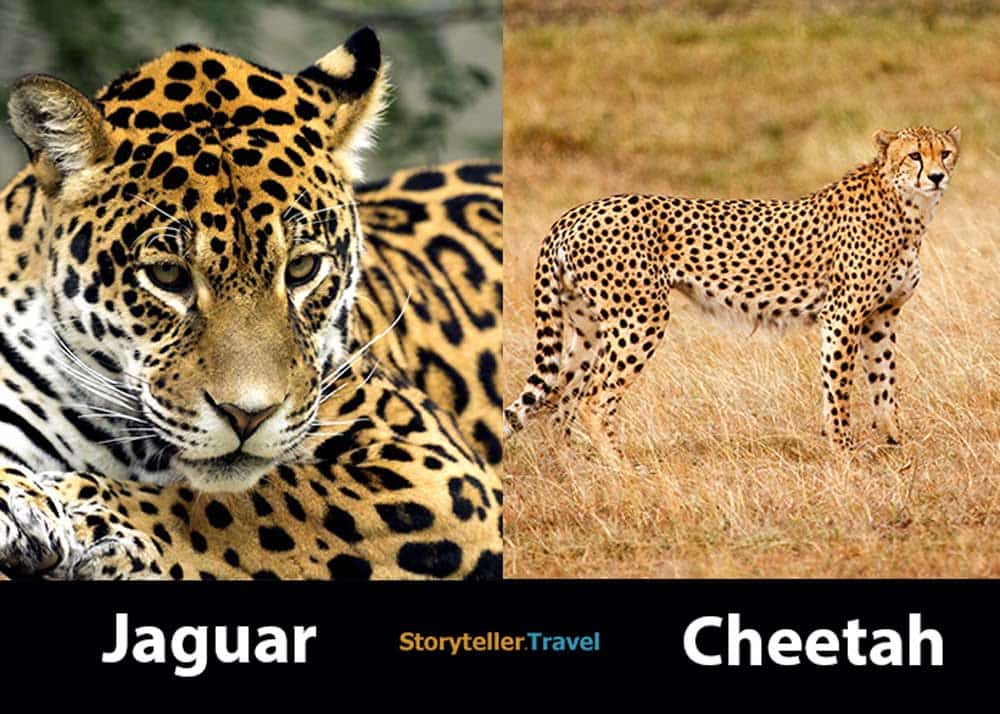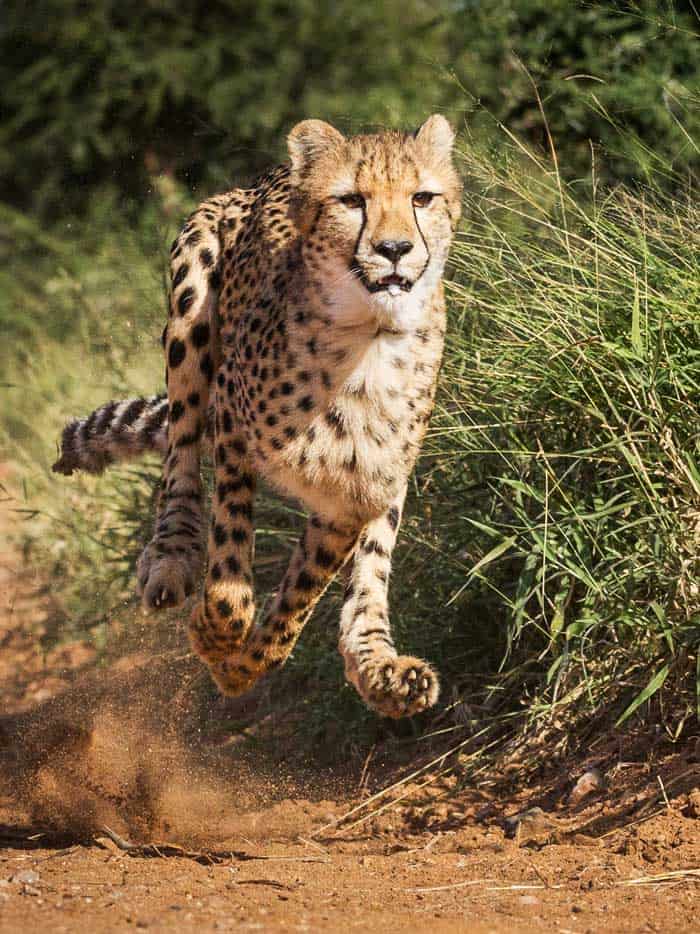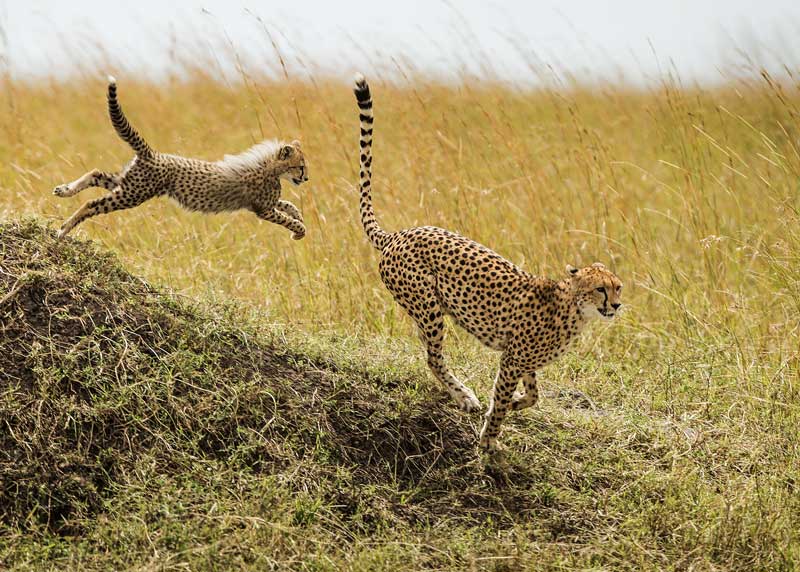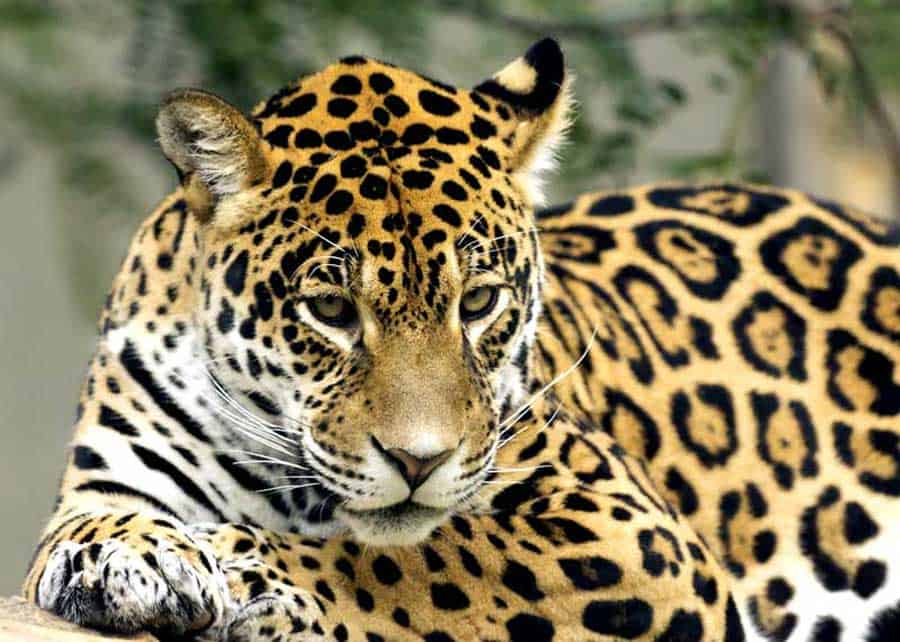Jaguar vs Cheetah: 8 Key Differences Compared (Markings, Habitat, etc)
What’s the difference between jaguars vs cheetahs? These two big cats have quite a few interesting points to compare, from size to markings to speed. In this post, we’ll take a look at 8 key differences between jaguars and cheetahs.
Jaguars and cheetahs are both large cat species. And while they have a similar appearance, they are quite different. Jaguars live in the Americas and cheetahs live in Africa and Iran. Although they never meet in the wild, in a jaguar vs cheetah fight the jaguar would almost certainly win.

Jaguar vs Cheetah: Quick Overview
Here are the facts about both jaguars and cheetahs.
Jaguar Facts
- Latin Name: Panthera onca
- Location: Central and South America
- Habitat: Dense forests, wetlands, grasslands
- Size:
- Length: Up to 6 ft 1 in (1.85 m)
- Tail Length: Up to 30 inches (76 cm)
- Shoulder Height: up to 29.5 inches (75 cm)
- Weight: usually up to 212 pounds (96 kg), some males have been recorded at 348 pounds (158 kg)
- Speed: Estimated 50 mph (80 km/h)
- Lifespan: 12-15 years in the wild; 20 years in captivity
- Population: 15,000
- Key Physical Features: Yellow or tan fur covered by spots and rosettes
Cheetah
- Latin Name: Acinonyx jubatus
- Location: Throughout Africa and Iran
- Habitat: a variety of habitats, including savannahs, dry mountain ranges, hilly deserts
- Size:
- Length: Up to 4 ft 11 in (1.5 m) long
- Tail Length: Up to 31 in (79 cm)
- Shoulder Height: just over 36 inches (91 cm) shoulder height
- Weight: 159 pounds (72 kg)
- Speed:
- Estimated: 76 mph (122 km/h)
- Recorded: 61 mph (98 km/h)
- Lifespan: 8-10 years in the wild; 15-20 years in captivity
- Population: 7,000
- Key Physical Features: Lean body meant for speed, with tan fur and whitish belly covered in spots
Jaguar vs Cheetah: 8 Differences Compared
The following is the list of 8 key differences between jaguars and cheetahs.
1. Location and Habitat
Jaguars and cheetahs can be found in different parts of the world and generally in different climates.
- Jaguars are found in Central and South America and live in dense forests, wetlands, and grasslands.
- Cheetahs can be found a continent over in Africa, with some pockets in West Asia, Iran specifically. They can be found in habitats like savannahs, dry mountain ranges, and hilly deserts, and they rarely are found in dense forests. Cheetahs prefer to be in areas where they can utilize their speed.
2. Size and Weight
Jaguars are usually bigger than cheetahs.
- Jaguars can get to 6 ft 1 in long (1.85 m) with a 30-inch (76 cm) tail, 31 inches in shoulder height, and weigh up to 212 pounds (96 kgs).
- Cheetahs, on the other hand, are built for speed. They can get up to 4 ft 11 in (1.5 m) long with a 31-inch (76 cm) tail, over 36 inches (91 cm) shoulder height, and a weight of 159 pounds (76 kg).
3. Fur and Markings
Generally speaking, jaguars and cheetahs have tan fur with dark spots. But their spots are where we can see a big difference.
- Jaguars can have black or dark markings called rosettes on their body, called that because of the flower-like shape of many of their markings
- Cheetahs have solid markings on their body, either round or oval-shaped.
4. Genus
Jaguars and cheetahs aren’t in the same genus.
- Jaguars are in the genus Panthera. They’re included with these other big cats: leopards, lions, snow leopards, and tigers. One feature that these big cats all have is the ability to roar.
- Cheetahs are in the genus Acinonyx. They’re the only living species that can be found in this genus. Cheetahs are also in the subfamily Felinae. Unlike jaguars, cats in this subfamily can’t roar. But cheetahs do have the ability to purr.
5. Genetic Variety
Both jaguars and cheetahs have interesting genetic varieties.
- Jaguars can be born with a genetic mutation where their fur can be black. They can be known as black panthers. This can also take place with the jaguar’s cousin, the leopard. Learn more about them here.
- Cheetahs can have a genetic mutation where they have dark splotches instead of spots, and black stripes on their backs. They’re known as king cheetahs.
Here’s how cheetahs compare to leopards.
6. Speed
This section is where cheetahs trump jaguars.
- Jaguars are no slouch themselves, getting up to speeds of 50 mph (80 km/h).
- Cheetahs are kings of speed for land animals. The fastest recorded speed of a cheetah is 61 mph (98 km/h), but some estimates have them going up to as fast as 76 mph (122 km/h)! They’re quick too, able to get to go 0-60 mph in about 3 seconds.
Cheetahs are the fastest land animals in Africa and the world.

7. Population Numbers
In this regard, there are more than double the number of jaguars in the world than cheetahs
- Jaguars: There are 15,000 jaguars left around the world. They are considered to be Near Threatened in conservation status.
- Cheetahs: There are estimates of around 7,000 cheetahs left in the wild today. For their conservation status, they’re considered to be a Vulnerable species.
Learn more about baby cheetahs.

8. Lifespan
For both jaguars and cheetahs, their lifespans are about 20 years in captivity.
In the wild, it’s a different story.
Jaguars can live about 12 to 15 years in their natural habitat, while cheetahs will live about 8 to 10 years in the wild.

Related: Jaguar vs Tiger: 7 Key Differences
This article is part of our huge set of animal guides: Animals of the World
Your Turn!
Which big cat would you like to meet, either these two or another one? What did you learn from this article? What other differences can you think of between jaguars vs cheetahs, and what did we miss?
Let us know in the comments below!






